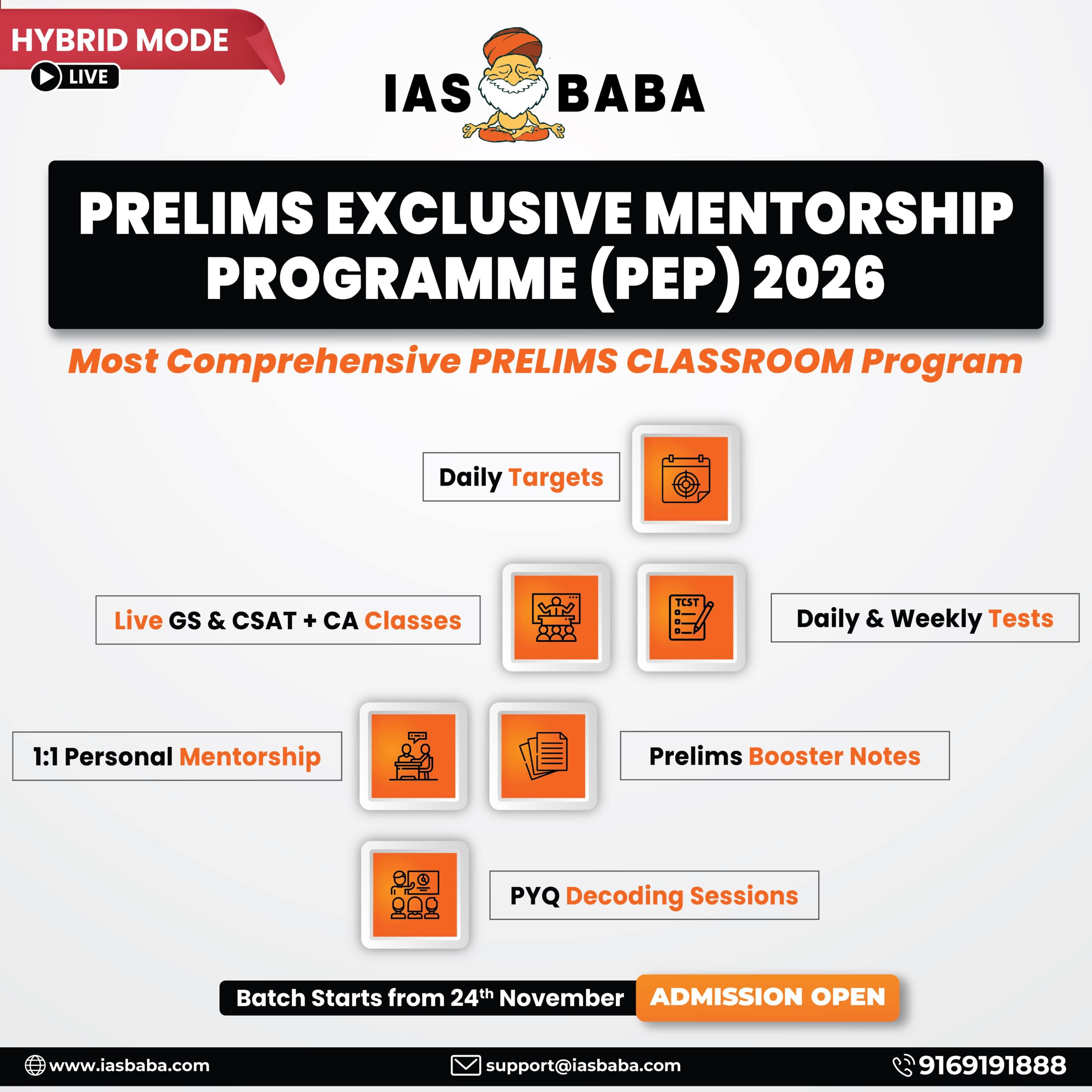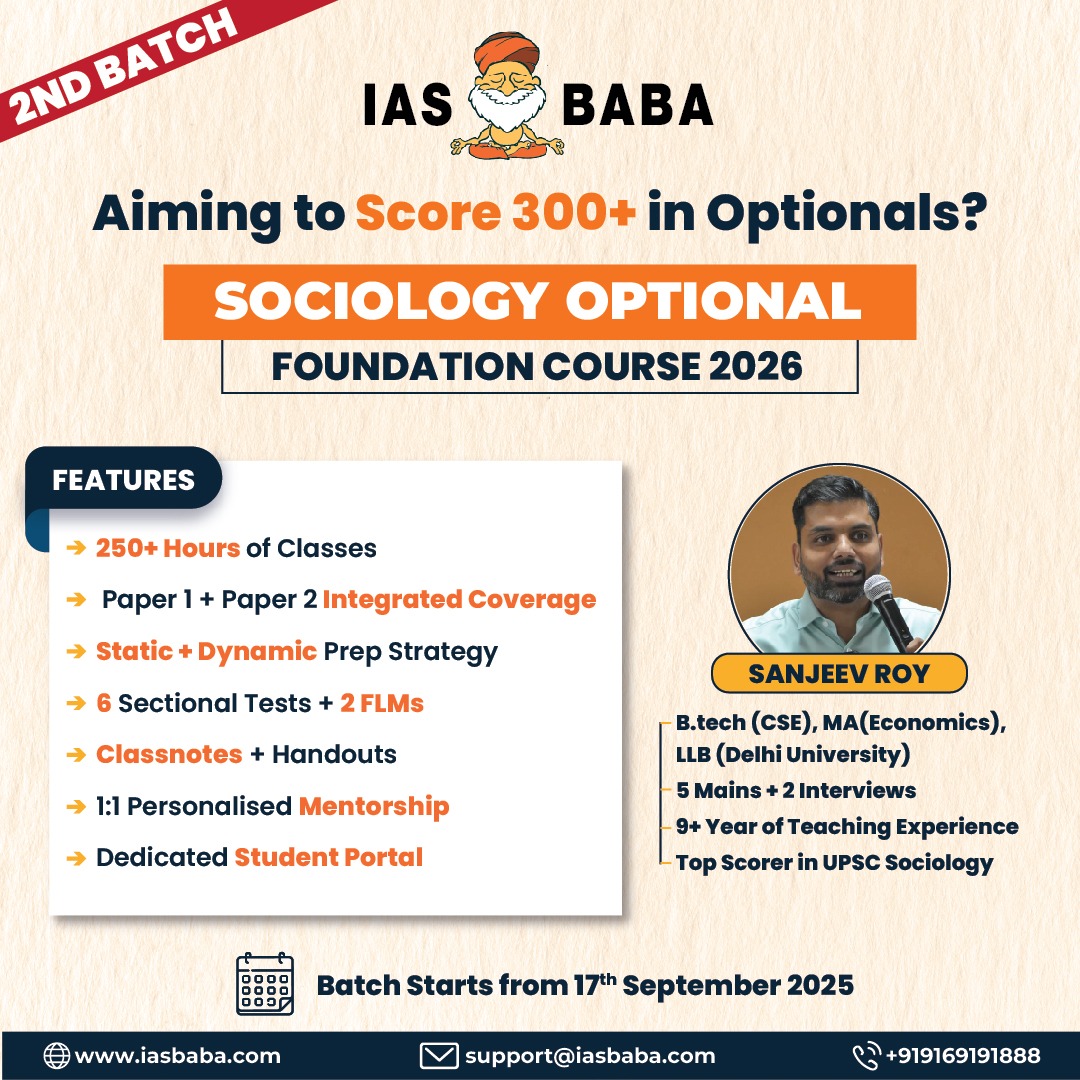IASbaba's Daily Current Affairs Analysis
rchives
(PRELIMS Focus)
Category: DEFENCE
Context: India has launched its first overseas defence manufacturing facility in Morocco, led by Tata Advanced Systems Limited (TASL).
- Defence Minister Rajnath Singh and his Moroccan counterpart inaugurated TASL’s first overseas defence plant in Berrechid, Morocco (20,000 sq. m).
- The facility will manufacture the indigenously developed WhAP 8×8 (by TASL and DRDO).
- Project aligns with India’s “Make with Friends” and “Make for the World” vision. It will generate local jobs, sourcing one-third of components locally, to rise to 50% in future.
- Aims to make Morocco a strategic defence manufacturing hub for Africa and Europe.
Learning Corner:
Indian Overseas Defence Facilities
- Farkhor Air Base, Tajikistan: Often regarded as India’s first overseas base. India has had an arrangement with Tajikistan for operating/supporting this base, mainly for strategic depth in Central Asia.
- Ayni (Gissar) Air Base, Tajikistan: Renovated and upgraded by India with extended runway, air traffic control and defence infrastructure. It can host IAF aircraft during contingencies, though full operational rights remain limited.
- IMTRAT, Bhutan: The Indian Military Training Team trains Bhutanese armed forces. It is one of India’s longest-standing overseas defence missions.
- Listening / Surveillance Posts: India is reported to maintain radar or surveillance facilities in parts of the Indian Ocean Region, such as Madagascar, to monitor maritime traffic and enhance domain awareness.
Source: THE HINDU
Category: SCIENCE AND TECHNOLOGY
Context : IPR Gandhinagar has outlined a roadmap to build SST-Bharat, a steady-state superconducting tokamak, aiming for fusion and fusion–fission hybrid power demonstration by mid-century.
- Core Device: Focus on SST-Bharat, a steady-state superconducting tokamak for long-duration plasma.
- Hybrid Approach: Fusion-fission hybrid considered to boost net output.
- Q Factor Goal: Improve power gain (Q > 1) beyond past sub-unity results.
- Plasma Sustainment: Aim for steady-state, multi-minute plasmas; SST-1 progress noted.
- Magnetic Confinement: Chosen route over inertial confinement; needs ~100 million °C plasma control.
- Superconducting Tech: Advanced superconducting magnets and cryogenics are key.
- Materials Challenge: Develop divertors and plasma-facing components to withstand heat/erosion.
- Heating & Current Drive: Requires neutral beams, RF heating, and non-inductive drives.
- Digital Twinning: Virtual replicas to model, test, and troubleshoot.
- R&D Priorities: Magnets, radiation-hard materials, plasma models, high-temperature engineering.
- Timelines: Experiments to prototypes (~2040), demo reactor by mid-century/2060.
- Caveats: Commercial viability uncertain; hinges on breakthroughs in confinement, materials, and economics
Learning Corner:
ITER (International Thermonuclear Experimental Reactor):
- Overview: ITER is the world’s largest international collaborative project in nuclear fusion research, under construction at Cadarache, France.
- Members: It involves 35 countries, including India, EU, USA, Russia, China, Japan, and South Korea.
- Objective: To demonstrate the feasibility of fusion power as a large-scale, carbon-free energy source by producing self-sustaining plasma.
- Technology: ITER is a tokamak (doughnut-shaped magnetic confinement device) designed to confine plasma at over 150 million °C, using powerful superconducting magnets.
- Power Goal: ITER aims for a Q ≥ 10, meaning it will generate 10 times more fusion power (500 MW) than the external heating power required (50 MW).
- Timeline: First plasma is targeted for the 2030s (delayed from original 2025).
- India’s Role: India, through the Institute for Plasma Research (IPR), Gandhinagar, contributes critical components like cryostat, cooling systems, in-wall shielding, and diagnostic tools.
- Significance: ITER is not a power plant but a demonstration facility — a stepping stone toward future demonstration and commercial fusion reactors (DEMO stage).
Source: THE HINDU
Category: ENVIRONMENT
Context: Union Environment Ministry’s expert committee has given clearance to the 2,200 MW Oju Hydroelectric Project on the Subansiri river in Arunachal Pradesh, near the China border.
Key Summary in Bullet Points
- Location & Project Details
- Proposed on the Subansiri river in Upper Subansiri district, Arunachal Pradesh.
- Close to the China border; part of India’s border infrastructure push.
- To be developed by Oju Subansiri Hydro Power Corporation Pvt. Ltd.
- Technical Features
- Installed capacity: 2,200 MW.
- Dam type & height: Gravity dam, 120 m high.
- Reservoir: Submergence area of 434 hectares forest land (total diversion of ~750 hectares forest).
- Annual design energy: ~7,934 million units.
- Displacement: Only nine families affected.
- Strategic & Development Significance
- One of India’s largest hydroelectric projects.
- Strengthens infrastructure in Northeast, especially near the China border.
- Boosts India’s renewable energy capacity.
- Concerns & Criticism
- The Cumulative Impact Assessment (CIA) and Carrying Capacity Study (CCS) of the Subansiri basin were done in 2014, now considered outdated.
- Critics warn of landslides, dam-break scenarios, flash floods, and ecological impacts in the fragile Himalayan terrain.
- Environmentalists argue that the approval process did not sufficiently update scientific studies before clearance.
Learning Corner:
Subansiri River – Overview
- Origin: Rises in the Tibet Plateau (China), where it is known as the Chayul Chu.
- Course: Flows east and south-east through Tibet, then enters Arunachal Pradesh (India) near Taksing, before flowing into Assam, where it joins the Brahmaputra River at Lakhimpur district.
- Length: About 442 km (192 km in Tibet, 250 km in India).
- Significance: Largest tributary of the Brahmaputra, draining a major part of the Eastern Himalayas.
Tributaries of Subansiri
- Right-bank tributaries: Kamla, Kurung, Panior, Ranga Nadi.
- Left-bank tributaries: Panyor, Dikrong, Pare.
- Collectively these streams drain the Upper Subansiri basin and feed the main Subansiri channel before it meets the Brahmaputra.
Hydroelectric Projects on Subansiri
- Lower Subansiri Hydroelectric Project (2000 MW)
- Located at Gerukamukh (on Assam–Arunachal border).
- Being developed by NHPC.
- India’s largest hydroelectric project under construction, but facing delays due to environmental and safety concerns.
- Upper Subansiri Projects (Cascade system)
- Includes projects like Oju (2200 MW), Niare, Naba, Nalo, Denger, and others.
- Together, they form a series of cascade hydropower projects planned to harness the river’s steep gradient in Arunachal Pradesh.
- Oju Subansiri Hydroelectric Project (2200 MW)
- Recently given environmental clearance (Sept 2025).
- Located near Taksing in Upper Subansiri, close to the China border.
- To be developed by Oju Subansiri Hydro Power Corporation Pvt. Ltd.
Source: THE INDIAN EXPRESS
Category: GEOGRAPHY
Context Hong Kong shut down as Super Typhoon Ragasa, the world’s most powerful tropical cyclone of the year, approached southern China.
- Nature: Ragasa is the world’s most powerful tropical cyclone of 2025 so far, classified as a super typhoon due to its wind intensity.
- Winds: Reached sustained speeds of ~220 km/h (137 mph), with potential to intensify further.
- Trajectory:
- Originated over the western Pacific Ocean.
- Swept across the northern Philippines and lashed Taiwan with heavy rains and winds.
- Now moving toward the southern coast of China, including Hong Kong, Guangdong, and Macau.
- Impact in Hong Kong:
- City went into shutdown, suspending most passenger flights until Thursday.
- Panic buying reported in supermarkets, residents taped up windows to reduce damage.
- Impact in Taiwan:
- At least 2 deaths and 30 missing due to floods and a barrier lake bursting its banks.
- China (Guangdong):
- Over 770,000 people evacuated, more than 1 million homes without power.
- Authorities bracing for severe flooding, landslides, and storm surges.
Learning Corner:
What is a Typhoon / Cyclone?
- A tropical cyclone is a rapidly rotating storm system characterized by a low-pressure center, strong winds, and heavy rain.
- It forms over warm ocean waters (≥ 26.5°C) and derives energy from latent heat of condensation.
- Depending on the ocean basin and regional naming conventions, it is called by different names.
Different Regional Names for Cyclones
- Cyclone → Indian Ocean & South Pacific Ocean
- Example: Cyclone Fani (2019, Bay of Bengal).
- Typhoon → Northwest Pacific Ocean (East & Southeast Asia: China, Japan, Philippines, Taiwan, Hong Kong).
- Example: Typhoon Haiyan (2013, Philippines).
- Hurricane → North Atlantic Ocean & Northeast Pacific Ocean (Caribbean, Gulf of Mexico, USA, Central America).
- Example: Hurricane Katrina (2005, USA).
- Willy-Willy → Australia region (Australian waters of the South Pacific & Indian Ocean).
- Bagyo → Local term in the Philippines for tropical cyclones.
Classification (based on wind speed – Indian Meteorological Department)
- Tropical Depression: < 63 km/h
- Cyclonic Storm: 63–88 km/h
- Severe Cyclonic Storm: 89–117 km/h
- Very Severe Cyclonic Storm: 118–165 km/h
- Extremely Severe Cyclonic Storm: 166–220 km/h
- Super Cyclonic Storm: > 220 km/h
Source: THE INDIAN EXPRESS
Category: POLITY
Context: It is a five-day initiative to strengthen civil–military engagement and strategic leadership in national security organised by HQ IDS in New Delhi.
- Purpose: Enhances strategic awareness, fosters civil–military engagement, and equips senior leaders with balanced perspectives for national security decision-making.
- Key Themes:
- Regional and global security challenges.
- Technological transformation in warfare.
- Role of strategic communication in modern conflicts.
- Civil–military synergy for multidimensional threats.
- Features:
- Five-day event with subject experts and professionals.
- Exposure to contemporary national and international security issues.
- Interactive problem-solving to promote inter-service jointness.
- Strategic Significance: Strengthens civil–military cooperation and prepares future leaders to handle complex security environments.
Learning Corner:
Programmes that foster civil–military engagement in India:
Higher Defence Management Course (HDMC)
- Conducted at the College of Defence Management (CDM), Secunderabad.
- Focuses on joint planning, higher defence organisation, and synergy between military and civilian leadership.
- Attended by senior armed forces officers and civil service officers.
National Defence College (NDC) Course
- Conducted at New Delhi.
- One-year course for senior military officers, civil servants, diplomats, and foreign officers.
- Builds understanding of national security strategy, geopolitics, and civil–military cooperation.
Higher Command and Senior Command Courses
- Run at the Army War College, Mhow.
- Include participation of civil service officers, fostering joint leadership perspectives on operational and strategic issues.
Defence Management Programmes with Civil Institutions
- Collaborations between defence organisations and institutes like IIMs and IITs for leadership, technology, and management training.
- Encourage cross-learning between civil academia and armed forces.
Joint Civil–Military Training at LBSNAA
- Modules at the Lal Bahadur Shastri National Academy of Administration (Mussoorie) bring together IAS probationers and young defence officers.
- Enhances understanding of each other’s roles in governance and security.
National Security Council Secretariat (NSCS) Workshops & Tabletop Exercises
- Involve civil services, police, and armed forces.
- Aim at improving inter-agency coordination during crises.
Source: PIB
(MAINS Focus)
Introduction (Context)
In Subramanian Swamy v. Union of India (2016), the Supreme Court upheld criminal defamation under Sections 499–500 IPC, stating that reputation is part of the Right to Life under Article 21.
- Yet, recent instances—such as the conviction of politicians and journalists for remarks against public figures—show how these provisions are increasingly used to intimidate critics and shrink democratic debate, raising concerns over free speech under Article 19(1)(a).
What is Defamation?
- Defamation is any false statement that lowers a person’s reputation.
- Civil Defamation: Handled under tort law, resolved through damages, apology, or injunction.
- Criminal Defamation: Offence under IPC Sections 499–500, punishable by up to 2 years’ imprisonment or fine.
- Exceptions: Fair comment, truth, and statements in public interest (e.g., investigative reports exposing corruption).
Recent Misuse and Concerns
- Politicians using law against critics: In 2023, Rahul Gandhi was convicted in a criminal defamation case over remarks about a surname, highlighting its political weaponization.
- Targeting journalists: Reporters exposing scams often face multiple defamation cases across states, leading to harassment and litigation burden.
- Chilling effect on free speech: Editors Guild of India flagged that criminal defamation creates self-censorship among media houses.
- Judicial backlog: NCRB data (2023) shows over 20,000 pending cases, with low conviction rates but high harassment value.
- Lower courts’ easy summons: Ordinary criticism of government policies is sometimes dragged into criminal trials until higher courts intervene.
Global Perspective
- Democracies like the U.K. (2009), Ghana, and Sri Lanka have abolished criminal defamation.
- The U.S. Supreme Court (New York Times v. Sullivan, 1964) elevated protection for speech against public officials.
- UN Human Rights Committee has repeatedly urged countries to remove imprisonment as a punishment for defamation.
Critical Analysis
- Supporters argue that Indian society lacks robust civil law enforcement, making criminal defamation necessary to deter malicious attacks.
- However, experience shows that it disproportionately benefits powerful actors while discouraging investigative journalism, satire, and political critique.
- A balance must be struck where reputation is protected through civil remedies, not jail terms.
Steps Needed
- Decriminalize defamation: Repeal prison terms under IPC Sections 499–500, retain civil remedies like damages and injunctions.
- Fast-track civil defamation courts: Ensure timely justice to aggrieved citizens.
- Stricter judicial filters: SC/HC should set higher thresholds for lower courts before issuing summons.
- Awareness of exceptions: Promote legal education on public good and fair comment defences to safeguard legitimate criticism.
- Legislative review: Law Commission and Parliament should revisit defamation law to align with constitutional morality and global practices.
Conclusion
Recent cases show that criminal defamation is often wielded less as a protector of reputation and more as a weapon against dissent. India’s democratic maturity requires a shift to civil remedies, which sufficiently uphold reputation without chilling free speech. Decriminalizing defamation will strengthen democratic accountability and protect individual dignity simultaneously.
Mains Practice Question
- Criminal defamation law in India, though constitutionally upheld, is increasingly criticized for its chilling effect on free speech. Examine with recent examples. (250 words, 15 marks)
Introduction
India’s transgender population—4.87 lakh in Census 2011—continues to face deep-rooted exclusion in education, healthcare, and livelihoods. Despite legal advances, their lived realities expose the gap between formal recognition and substantive equality.
Constitutional and Legal Framework
- The Constitution’s vision of equality (Articles 14, 15, 21) is inclusive of all persons, yet enforcement remains uneven.
- Judicial interventions like NALSA (2014) recognized self-identification, but state-level rules often dilute this by demanding medical proof.
- The 2019 Act prohibits discrimination but has been criticized for weak penalties, lack of clarity on reservations, and over-centralization, raising questions about real empowerment.
- While Navtej Singh Johar (2018) decriminalized same-sex relations, social stigma continues to criminalize transgender existence informally, showing how law alone cannot alter entrenched social norms.
Key Challenges
- Identity recognition: Administrative processes contradict the principle of self-identification, forcing humiliating medical verification, which discourages access to welfare schemes.
- Family and community rejection: Rejection is not just emotional but pushes individuals into unsafe spaces, increasing vulnerability to trafficking and exploitation.
- Educational exclusion: High dropout rates reflect not just bullying but the absence of gender-neutral facilities and safe environments, leading to a vicious cycle of low skills and poor employability.
- Economic marginalization: Reservations remain unclear; private sector hiring is minimal. Many are forced into informal or stigmatized occupations, reflecting how economic structures reproduce social exclusion.
- Healthcare neglect: Beyond transition care, basic health services remain inaccessible due to prejudice among medical professionals. Lack of insurance coverage aggravates this exclusion.
- Housing discrimination: Landlords’ refusal to rent reflects deep cultural bias. Without stable housing, access to jobs and social security collapses, reinforcing marginalization.
- Political invisibility: Absence in legislatures leads to “policy about them without them.” The symbolic election of a few representatives is insufficient without institutionalized participation.
Priorities for Reform
- Education: Inclusion must go beyond access to address retention—through gender-sensitive teacher training, curriculum reform, and scholarships to break cycles of exclusion.
- Healthcare: Gender-affirmative care should be part of Ayushman Bharat, while medical education must embed gender sensitivity as a core competency.
- Employment: Enforcing workplace diversity policies, providing skill development, and extending reservations into higher education and government jobs can shift economic mobility.
- Housing: Anti-discrimination rental laws, coupled with state-supported hostels, can ensure stability and dignity in urban as well as rural spaces.
- Political empowerment: Reserved seats in local bodies and legislatures would institutionalize representation, making transgender voices central to policymaking rather than peripheral.
- Social awareness: Law enforcement, education systems, and media must collectively normalize gender diversity, challenging entrenched stereotypes that perpetuate exclusion.
Social Insights
- Structural exclusion: Institutions like family, school, and workplace perpetuate discrimination, showing that legal rights cannot operate in isolation.
- Intersectionality: Many transgender persons face overlapping vulnerabilities of caste, poverty, and rural disadvantage, making targeted interventions essential.
- Governance gaps: Policy remains largely top-down, treating transgender persons as beneficiaries rather than stakeholders, weakening ownership and effectiveness.
Conclusion
The struggle of transgender persons is not for welfare but for justice and dignity. Bridging the gap between law and lived reality requires moving beyond tokenism to genuine empowerment through education, healthcare, employment, and political participation. Only then will India’s democracy fulfill its promise of equality for all identities.
Mains Practice Question
- Despite progressive judgments and the Transgender Persons (Protection of Rights) Act, 2019, the transgender community in India continues to face systemic exclusion. Discuss. (250 words, 15 marks)
Source: https://www.thehindu.com/opinion/op-ed/trans-people-deserve-better/article70080940.ece













